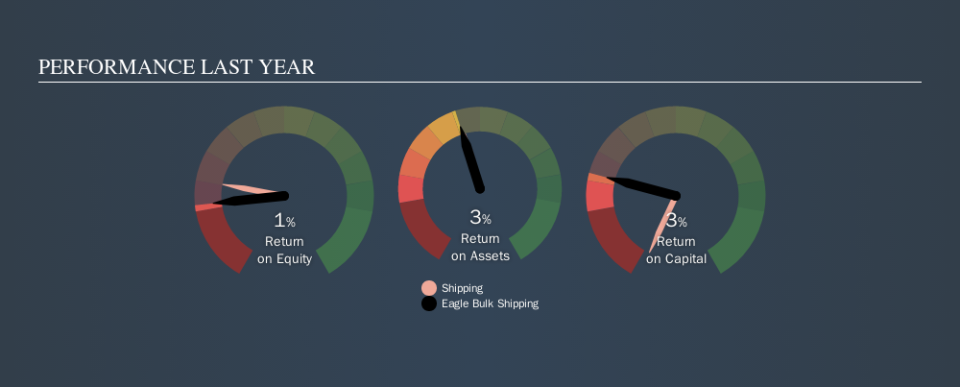Should Eagle Bulk Shipping Inc.’s (NASDAQ:EGLE) Weak Investment Returns Worry You?

Today we'll look at Eagle Bulk Shipping Inc. (NASDAQ:EGLE) and reflect on its potential as an investment. Specifically, we'll consider its Return On Capital Employed (ROCE), since that will give us an insight into how efficiently the business can generate profits from the capital it requires.
First, we'll go over how we calculate ROCE. Next, we'll compare it to others in its industry. Then we'll determine how its current liabilities are affecting its ROCE.
Return On Capital Employed (ROCE): What is it?
ROCE is a measure of a company's yearly pre-tax profit (its return), relative to the capital employed in the business. In general, businesses with a higher ROCE are usually better quality. In brief, it is a useful tool, but it is not without drawbacks. Author Edwin Whiting says to be careful when comparing the ROCE of different businesses, since 'No two businesses are exactly alike.
So, How Do We Calculate ROCE?
The formula for calculating the return on capital employed is:
Return on Capital Employed = Earnings Before Interest and Tax (EBIT) ÷ (Total Assets - Current Liabilities)
Or for Eagle Bulk Shipping:
0.03 = US$24m ÷ (US$864m - US$74m) (Based on the trailing twelve months to June 2019.)
So, Eagle Bulk Shipping has an ROCE of 3.0%.
Check out our latest analysis for Eagle Bulk Shipping
Does Eagle Bulk Shipping Have A Good ROCE?
One way to assess ROCE is to compare similar companies. Using our data, Eagle Bulk Shipping's ROCE appears to be significantly below the 5.2% average in the Shipping industry. This could be seen as a negative, as it suggests some competitors may be employing their capital more efficiently. Putting aside Eagle Bulk Shipping's performance relative to its industry, its ROCE in absolute terms is poor - considering the risk of owning stocks compared to government bonds. Readers may wish to look for more rewarding investments.
Eagle Bulk Shipping has an ROCE of 3.0%, but it didn't have an ROCE 3 years ago, since it was unprofitable. This makes us wonder if the company is improving. You can click on the image below to see (in greater detail) how Eagle Bulk Shipping's past growth compares to other companies.
Remember that this metric is backwards looking - it shows what has happened in the past, and does not accurately predict the future. Companies in cyclical industries can be difficult to understand using ROCE, as returns typically look high during boom times, and low during busts. ROCE is, after all, simply a snap shot of a single year. Since the future is so important for investors, you should check out our free report on analyst forecasts for Eagle Bulk Shipping.
Do Eagle Bulk Shipping's Current Liabilities Skew Its ROCE?
Current liabilities include invoices, such as supplier payments, short-term debt, or a tax bill, that need to be paid within 12 months. Due to the way ROCE is calculated, a high level of current liabilities makes a company look as though it has less capital employed, and thus can (sometimes unfairly) boost the ROCE. To counter this, investors can check if a company has high current liabilities relative to total assets.
Eagle Bulk Shipping has total assets of US$864m and current liabilities of US$74m. As a result, its current liabilities are equal to approximately 8.5% of its total assets. Eagle Bulk Shipping has a low level of current liabilities, which have a negligible impact on its already low ROCE.
Our Take On Eagle Bulk Shipping's ROCE
Nonetheless, there may be better places to invest your capital. But note: make sure you look for a great company, not just the first idea you come across. So take a peek at this free list of interesting companies with strong recent earnings growth (and a P/E ratio below 20).
Eagle Bulk Shipping is not the only stock insiders are buying. So take a peek at this free list of growing companies with insider buying.
We aim to bring you long-term focused research analysis driven by fundamental data. Note that our analysis may not factor in the latest price-sensitive company announcements or qualitative material.
If you spot an error that warrants correction, please contact the editor at editorial-team@simplywallst.com. This article by Simply Wall St is general in nature. It does not constitute a recommendation to buy or sell any stock, and does not take account of your objectives, or your financial situation. Simply Wall St has no position in the stocks mentioned. Thank you for reading.

